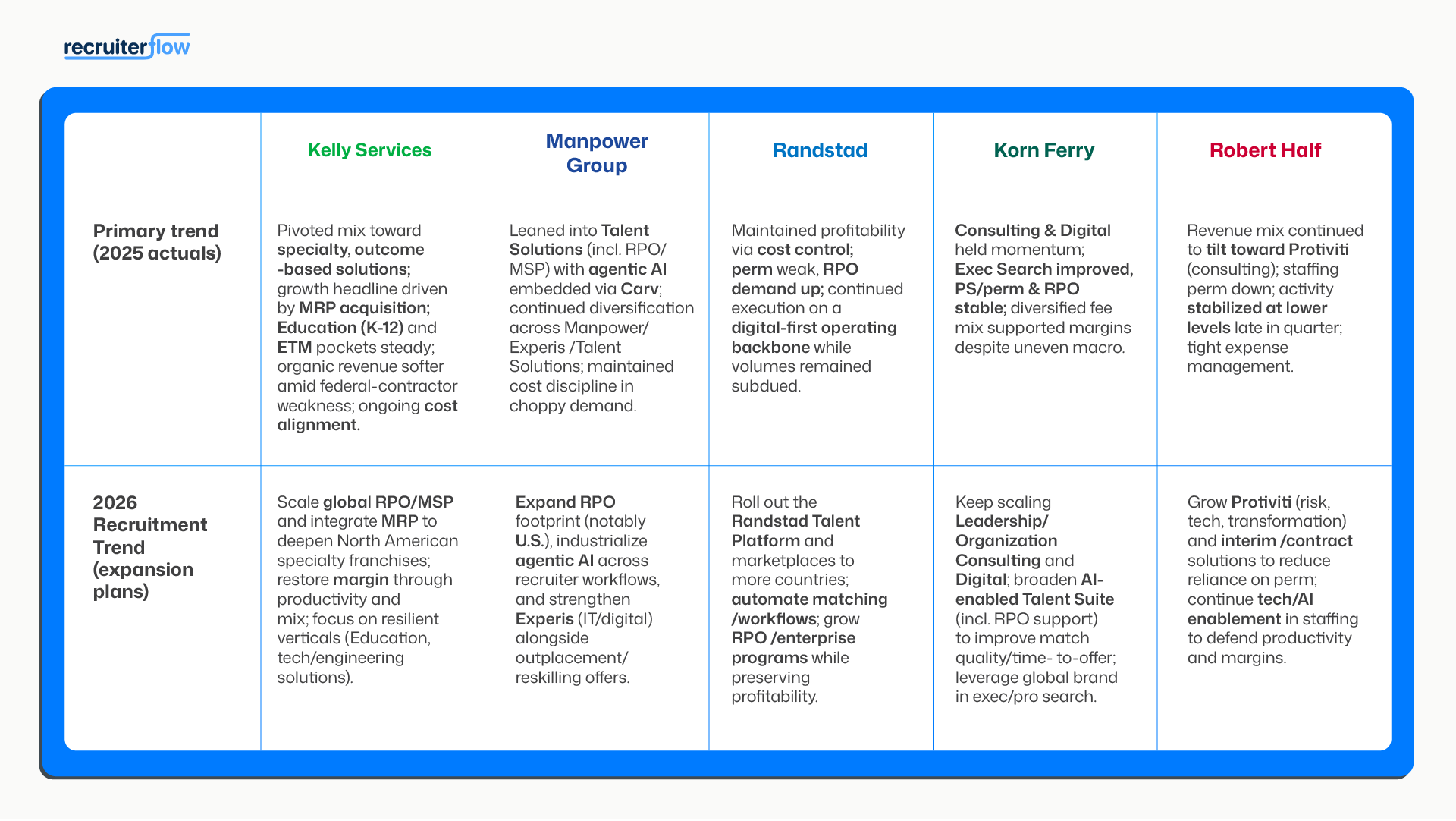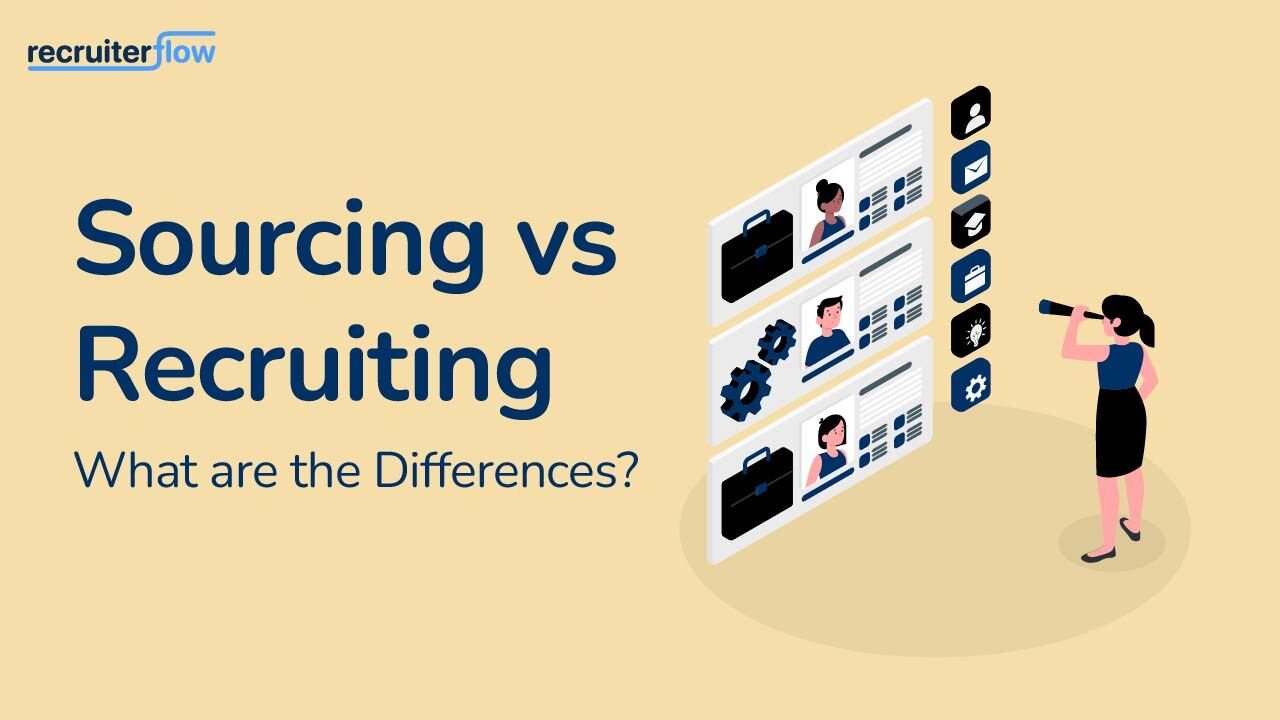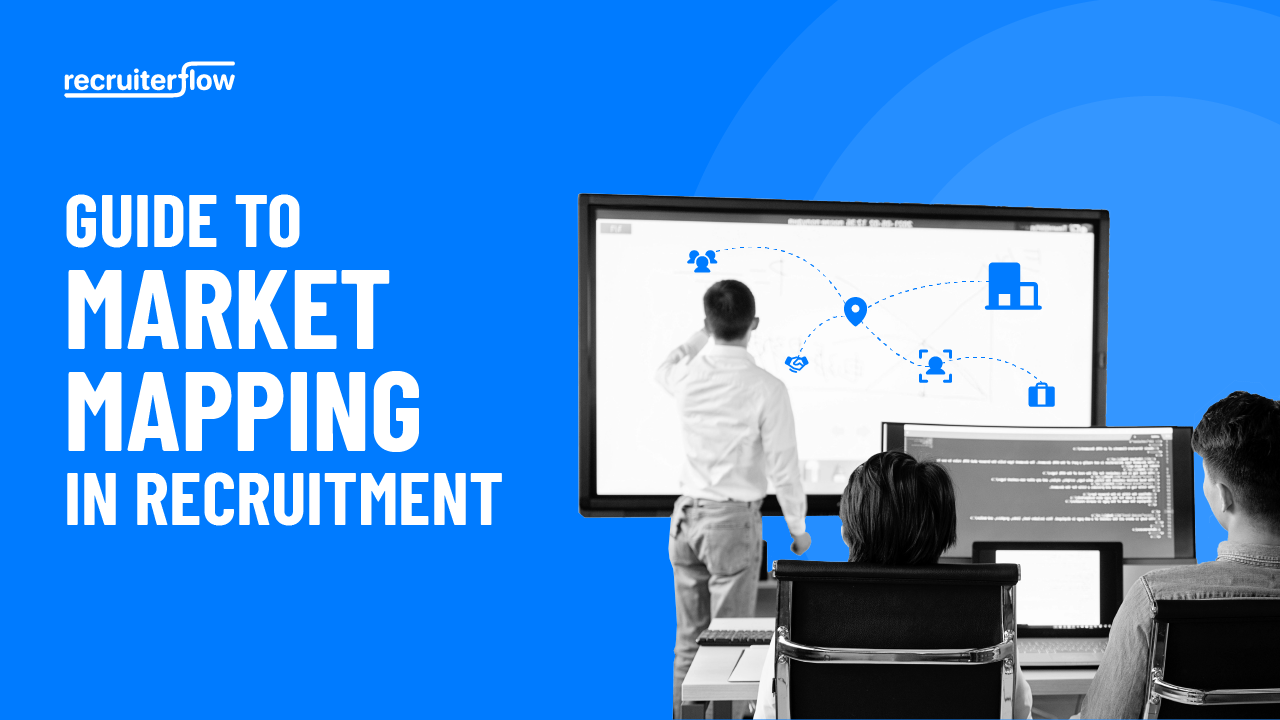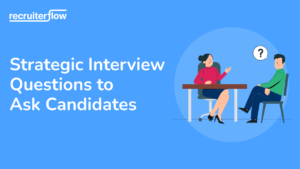
10 Recruitment Trends To Expect in 2026

If you’ve heard the quote, “Insanity is doing the same thing over and over again and expecting different results.” you probably know it’s misattributed to Albert Einstein. Whether he said it or not, it might as well have been written for the recruitment industry. The latest recruitment trends are not just about survival, but about a new, more resilient model for growth.
The past 8 quarters have forced market leaders to tighten their grip of profit margins—owing to the sustained economic uncertainties. Having said that, the second half of 2025 brings hope. Demands is changing. Clients demand a more strategic involvement from agencies and new models are taking shape, setting the foundations for 2026.
In this blog, we will uncover the top recruitment trends to expect in 2026. These are no-fluff recruiting trends that are based on the recruitment industry analysis.
10 Latest Recruitment Trends To Expect in 2026
- Diversification is the new normal
- AI’s role has changed from being a ‘factory robot’ to ‘strategic investment’
- AI Agents to redefine recruitment operations
- Building AI Twins to increase productivity and revenue
- The rise of RPO in the industry
- Candidate relationships will be more important than ever
- Using recruiting data for scale
- Skills based hiring
- Recruitment marketing will be the new lever
- The conundrum of reducing entry-level jobs
Diversification is the new normal
2025 was a defining year for the recruitment industry. The demand for permanent hiring took a massive hit forcing companies such as Korn Ferry, Robert Half, Manpower Group, Kelly Services, and Randstad Group to rethink service mix.
Diversification is not just a trend, but the foundation of the future of recruitment. The way we see it, there are three types of diversifications that will become prominent in 2026:
- Service Diversification Expanding beyond a single recruitment model to offer multiple talent solutions (Ex: Temp + RPO).
- Geographical Diversification Expanding to new regions or countries to capture new client markets and talent pools.
- Partnerships and M&A Recruitment firms will partner with, acquire, or merge with other companies to expand service offerings, enter new markets, or scale operations.
Here’s how the diversification looks across the big players:
AI in recruitment for Big Wins
Until the first half of 2025, Recruiting AI was treated like a factory robot, used extensively to perform simple, repetitive tasks at a greater scale than a human could (scraping through 100,000+ resumes, transcribing 100+ hours of calls for example).
2026 is the new era of AI. The role of AI will change from a solving for volume to solving for efficiency. AI Agents will become an integral part of the recruiters tech stack.
Having said that, the role of AI won’t be universal. It will be shaped by the utility, industry, and size of the agency.
Here’s a quick breakdown:
The Rise of AI Agents in Recruitment
ManpowerGroup has partnered with Carv to build in-house Agentic-AI capabilities. Robert Half has made notable advancements toward building agentic-AI. And the trend is similar across the industry giants.
AI agents in recruitment are the next big thing—and it’s about time. The idea isn’t to replace recruiters, rather to ensure recruiters focus on the ‘human’ side of recruiting alone.
Every Recruiters AI Twin
In 2026, the recruiters who will thrive will be the ones who can build their AI twins. Think of an ‘AI Twin’ as a digital team mate who works 24*7 to execute a set of tasks that help recruiters do more.
It’s parallel intelligence designed to handle all manual tasks in the background.
Here are the advantages of building an AI twin:
| Activity | Role of AI Twin | Est. Time Saved |
|---|---|---|
| Update CRM | Auto-update CRM after transcribing the conversation. Extract skills and salary expectations, understand context, update profile data | 3 Hours/Week |
| Sending Emails or LinkedIn messages | Creating follow-up emails or LinkedIn messages based on past interactions, job role, expectations etc. | 3 Hours/Week |
| Market Research | Uncover insights about the company/contact and share in a consumable format | 3 Hours/Week |
| Follow-ups & Reminders | Automatically setup reminders based on the conversation | 2 Hours/Week |
| Monitoring Database | Notify when contacts change jobs or designation | 2 Hours/Week |
By building an AI twin, recruiters can save at least 15 hours every week. The primary objective is to reduce recruiter’s burnout and increase productivity.
The Meteoric Rise of RPO
You’ve probably read or heard veterans claim that “the demand is shrinking.” Yes, the demand has reduced but the impact is not the same across the board. Clients are now building AI infrastructure in-house to take care of the ‘high-volume’ tasks.
This has fundamentally changed the role of a recruitment agency. Clients don’t want one-off vendors who can fill a role. Instead, they are looking for strategic partners who can solve a hiring problem.
RPO’s subscription-like model is the best suited to align with this. Industry giants such as Kelly Services and ManpowerGroup have seen a major rise in the demand for their RPO services.
It’s only a matter of time until it becomes the norm. 2026 will be the year of RPO — a recruitment trend that’s worthy of a mention.
Candidate Relationships
Recruiters are supposed to build relationships and close deals. Instead, they are neck-deep in admin work that takes up a majority of their time impacting candidate relationships adversely.
In fact, reports suggest that over 60% recruiters are burnt out due to repetitive admin work.
The evolution of AI is a blessing for recruiters. It can effectively take over admin saving recruiters at least 15-17 hours every week. But that’s only one aspect.
Recruiters can leverage AI to create a more immersive candidate experience. Reports suggest that over 66% candidates accept the offer when the experience is positive. Over 26% candidates rejected offers due to a sub-part experience.
Here are the three aspects of candidate experience worthy of every recruiters time:
1. Response Rates
Over 42% candidates expect a response from the hiring manager within 48 hours.
2. Transparency
We are officially in the era of GenZ workforce and they are redefining the future of recruitment. GenZ expect transparency throughout the process.
3. Personalisation
One in every three candidates feels that AI chatbots make the hiring experience impersonal. The key is to find a balance between AI for scale and AI for personalisation.
Data Driven Recruitment
According to Recruiterflow’s research, 63% of all placements come from existing data.
Everytime a new job order comes, recruiters rush to LinkedIn recruiter to find candidates only to rediscover the ones already sitting in their CRM—primarily because recruiters don’t trust their CRM.
More often than not, recruiters are paying twice to find the same candidates. In 2026, the accuracy of the database is as important, if not more, as the volume of data.
Skills Over Degrees
Skill-based hiring will be a primary focus in 2026. Instead of prioritising degrees or lengthy resumes, it focuses on what candidates can do. AI matching will soon be ubiquitous helping recruiters find candidates beyond keyword matching.
Clients are increasingly rewarding agencies who can solve a hiring problem over just filling a role. To do that, recruiters will have to look beyond the resume, analyse the skill, and assess candidate capabilities before creating a shortlist.
Recruitment Marketing
Recruitment isn’t about placements anymore — it’s about influence, positioning, and building long-term relationships. In 2026, recruitment marketing will become one of key recruitment trends to look out for. At its core, recruitment marketing is about positioning your agency as the ideal choice for clients and candidates alike. It is a proactive approach to build awareness and unlock new growth opportunities.
Also Read: The Complete Guide on Recruitment Marketing
Entry Level Job Cuts
When the markets are unpredictable, cost cutting is the first thing every founder turns to. With AI’s stronghold in executing repetitive tasks effectively, entry-level jobs are most likely to hit the worst.
In fact, a Korn Ferry report suggests that 43% of companies plan to replace roles with AI—operation/back-office staff (58%) and entry-level positions (37%) are the top targets.
Here’s the irony: every manager or a leader works their way up starting from the same entry level jobs. Eliminating these roles today will only create a gap between skill and critical thinking. So, the cost cutting of today will most likely become a talent crisis of tomorrow.
The Future of Recruitment
2025 was all about resilience. The macro-economic factors heavily influenced the operating strategies but the industry found a way to stay afloat. The advancements in AI are particularly astonishing. In just a few quarters, AI is evolved from being a factory robot to a strategic partner.
2026 will be the year of finding a new normal. The industry stands at an inflection point, with AI reshaping everything from candidate sourcing to client engagement. This isn’t incremental change—it’s a complete reimagining of how recruitment works. The winners will be those who move beyond experimentation to embed AI across their entire value chain, transforming it from a productivity tool into a competitive moat.
Recruitment









Akshad